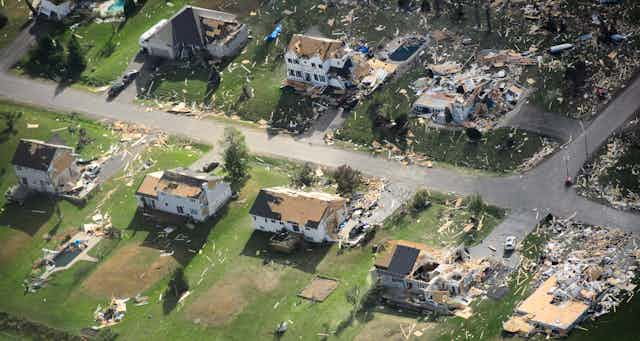Canadians are facing larger disasters on a more frequent basis. There is no doubt that some of these recent and future events are the result of an increasingly unstable climate.
Read more: Fiona hits Atlantic Canada: Climate change means the region will see more frequent storms
Whenever more people become exposed by living in hazardous parts of the country — including those not directly attributed to climate change such as earthquakes or train derailments — their disaster risk also increases. This combines with social and economic changes, like poverty and aging populations, to increase community vulnerability.
Despite these evolving challenges, our emergency management systems remain strongly rooted in civil defence practices developed during the Cold War. These systems are over-stressed by recent events and continue to be underfunded by provincial and federal governments.
Read more: Until we address chronic underfunding, Canada will keep failing at emergency management
Because Canadians tend only to pay close attention to these shortcomings when disasters occur, governments and the media remain focused on responding to disasters, not preventing or preparing for them.
Disasters cost billions
Natural and technological disasters represent a significant financial burden on citizens, businesses and governments. Disaster response actions and associated recovery assistance funds have cost approximately $5.75 billion over the past 10 years, according to Public Safety Canada.
However, proposals to increase response capabilities in isolation aren’t the most efficient way to reduce disaster risks. Canada, especially at the federal level, has developed strategies and made commitments to adopt a more comprehensive approach, but it’s failing to deliver results.
Canada’s Disaster Management Strategy acknowledges the value of hazard mitigation and community adaptation, but there is very little to require their implementation.
Instead of improving mitigation, changes to the national emergency management system currently being discussed in the national media include the creation of a federal disaster response agency.
But that’s not likely going to be effective in managing disasters in an uncertain social, economic and environmental future.
Read more: Why Canada’s political system makes it difficult to fight floods
One recognized problem is federal and provincial legislation is now out of date compared to emergency management best practices. These laws are overly dependent on the emergency powers stemming from our experiences in the last century.
In the 1950s, the provinces created “civil defence” systems against enemy attacks, with the option to use such systems in the event of natural disasters. These early laws became their first emergency management legislation. Governmental use of these existing powers, including suspending civil rights, has since been the only approach available.
It makes more sense for governments, as Prime Minister Louis St. Laurent stated in 1951 with regard to using the War Measures Act, “to avoid taking powers of the grave character which no democratic government wishes to have, as a government, unless those powers are really necessary for the safety of the state.”

Changing the Emergencies Act
A review of the existing Emergencies Act is clearly necessary.
The current wording establishes different powers available to the federal government under four types of emergencies.
Public welfare emergencies cover natural and technological disasters, while public order emergencies involve civil unrest, as was the case of the Emergencies Act’s use in February 2022 to end the so-called Freedom Convoy’s occupation of Ottawa.
The other two types are focused on national defence related to international emergencies and wars. This may contribute to the perception that disasters are a national defence responsibility.
The public welfare section of the Emergencies Act is clearly inappropriate and redundant considering provincial jurisdiction over emergency management. Provincial laws and systems cover the same range of special powers, and the Emergencies Act prevents the government of Canada from interfering in the provinces’ responses.
The section should be replaced with a process for the federal government to formally recognize provincial and municipal states of emergency. This would acknowledge decision-making belongs at the local and provincial level while giving federal cabinet ministers the ability to direct departmental resources to support provincial responses.
In fact, a provision in the federal Emergency Management Act that describes how Ottawa should prepare for disasters already sets a requirement for ministers to do this. It states: “Each minister shall include in an emergency management plan: (a) any programs, arrangements or other measures to assist provincial governments and, through the provincial governments, local authorities.”

No clear role
The current emergency management system, designed around the division of roles, responsibilities and powers between federal and provincial governments, does not have a clear role for a national response agency.
Nor can the Canadian Armed Forces continue to be tasked as a routine solution. The resources required in times of disaster go beyond the traditional 911 emergency services to include utilities, private and not-for-profit agencies and a greater role for citizen involvement. But these resources are located in provinces and organized locally.
Emergency management therefore needs to be integrated into decision-making by all levels of government and communities to be effective.
There are still unrealized opportunities to improve inter-provincial co-operation, and there’s still an urgent need for better funding. The creation of a response-focused national agency will not address these underlying problems.

